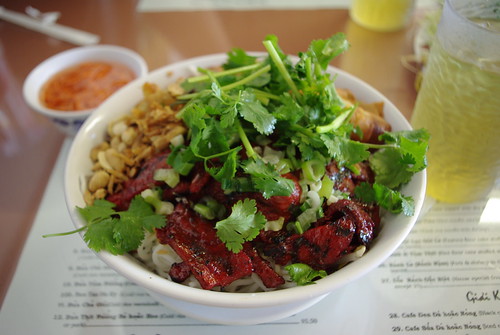About the Photos
- ISO 100 is incredible. ISO 1600 is good and can destroy my Fz7 at 100. The noise is well controlled in jpeg. When I use Pentax Photo Lab to convert the RAW files, the noise even has a film grain kind of quality which I like.
- The Auto ISO feature that automatically choose from a range is awesome. I get to spend more time thinking about aperture and shutter speed than worrying about ISO when I'm taking pictures of people.
- The output of Pentax Photo Lab is great, and the presets matches the camera almost exactly. I use natural and occasionally vibrant. Vibrant is the same as Miyabi in Japanese, which simulates the color on slide film.
- The shake reduction is really effective. I was able to handheld 1/8 seconds with no blur. I could do that do with the Fz7 but I didn't expect an SLR to be able to because of the mirror slap.
- Flash pictures look a little underexposed. I think either it's not powerful enough or I haven't dialed in enough compensation.
About Focus
- Viewfinder is smaller than the ZX-M! I was very shocked, because ZX-M 0.77x magnification, which is considered small in 35mm. The K200D is 0.85x, but it's of a smaller sensor, which is equivalent to about 0.57x...
- Auto focus is fast in bright light. In low light, it takes some time to lock on focus, especially if the subject is moving around. This makes it difficult to take people snapshots because they would start smiling as soon as the camera is pointed at them but the camera is still trying to focus...
- Manual focus is difficult with the plain matte screen. I might get a split image focusing screen or make one myself later.
- The quick shift focus mechanism is really nice.
- I like that AF is not linked to exposure (customizable). I sometimes focus and recompose and find that very nice.
About Lenses
- It was confusing at first to use a K mount lens without the A setting. It took me a while to find out the customization setting to allow using the aperture ring. After that, using the green button to find exposure is very easy.
- I got a DA16-45mm at the same time. Shouldn't have done that. Image contrast is better, and much sharper wide open (which I use most of the time when indoors). Lens cap was poor, because it's unusable when the lens hood is attached.
- My kit lens 18-55mm mk II front focuses in indoor yellowish light. Same thing happens to the focus confirmation dot when I use a Pentax-A 50mm f1.7. In natural light everything is normal. My 16-45mm does not have problem at all, which is quite curious.
- The K200D likes to underexpose my Pentax-A 50mm f1.7 by about 1 stop.
About Using DSLR in General
- It was heavy at first compared to my Panasonic Fz7. But after several days I already got used to the weight.
- People ask me why they hear a mechanical sound when I take a picture, "is that an old camera?"
- Some people mention they feel like their pictures are taken by paparazzi when I use burst mode to take two photos consecutively.
- The LCD is big and beautiful.
- I couldn't find the DOF preview button at first. Then I found the customization setting to change the digital preview to DOF preview. It is however quite useless in the small viewfinder, so I changed it back to digital preview (which basically takes a photo without saving it).
- The battery door is not as well built as my Fz7...
Conclusion
Overall, the image quality simply blew me away. The beautiful color and contrast made everything look more 3D. In particular, people's faces no longer look flat and round, which really pleases certain people. There are shortcomings, as expected with all entry-level DSLR, but they are all manageable with skill and practice. I am really pleased with my purchase.
Related
Sample Photo with Kit Lens II

